It’s a day by day grind. You already know, most small enterprise house owners and entrepreneurs begin their days with the analytics dashboard.
They attempt to make sense of the numbers, charts, and imprecise visitors sources like “social” or “direct” to find out what’s working for the enterprise, however these surface-level metrics don’t inform the entire story.
You want one thing to dig deeper. UTM parameters assist you to do exactly that. These small textual content tags added to your hyperlinks reveal the entire story of how clients discover you.
However first, what the heck are UTM parameters?
Understanding UTM Parameters
You already monitor your web site guests with Google Analytics.
Nonetheless, when somebody clicks a hyperlink to your website from Instagram, most analytics platforms can solely let you know they got here from “Natural Social.”
Alas, you possibly can’t ensure if the clicks got here out of your newest tweet, LinkedIn article, or Instagram story from final week.
With out this information, you don’t know what platform is definitely sending visitors to your web site.
If you happen to add distinctive UTM parameters to the hyperlinks you publish on social media platforms, your analytics platform can clearly present the place a sure click on got here from.
Take a look at this hyperlink with UTM parameters:
https://www.dreamhost.com/internet hosting/?utm_source=fb&utm_medium=social&utm_campaign=spring_sale_2025


- The whole lot earlier than the “?” is the bottom URL.
- The whole lot after it — the UTM parameters — carries monitoring info.
If you create tagged hyperlinks for every publish, you get to see which platform and what content material drives engagement.
With these hyperlinks created for every of your social media posts, it turns into straightforward to know precisely which publish from which platform resulted in a click on.
In Google Analytics, you’ll see the names you’ve added for these UTM parameters.
Check out the “Viewers Overview” part with “Session guide supply” chosen on the highest left.
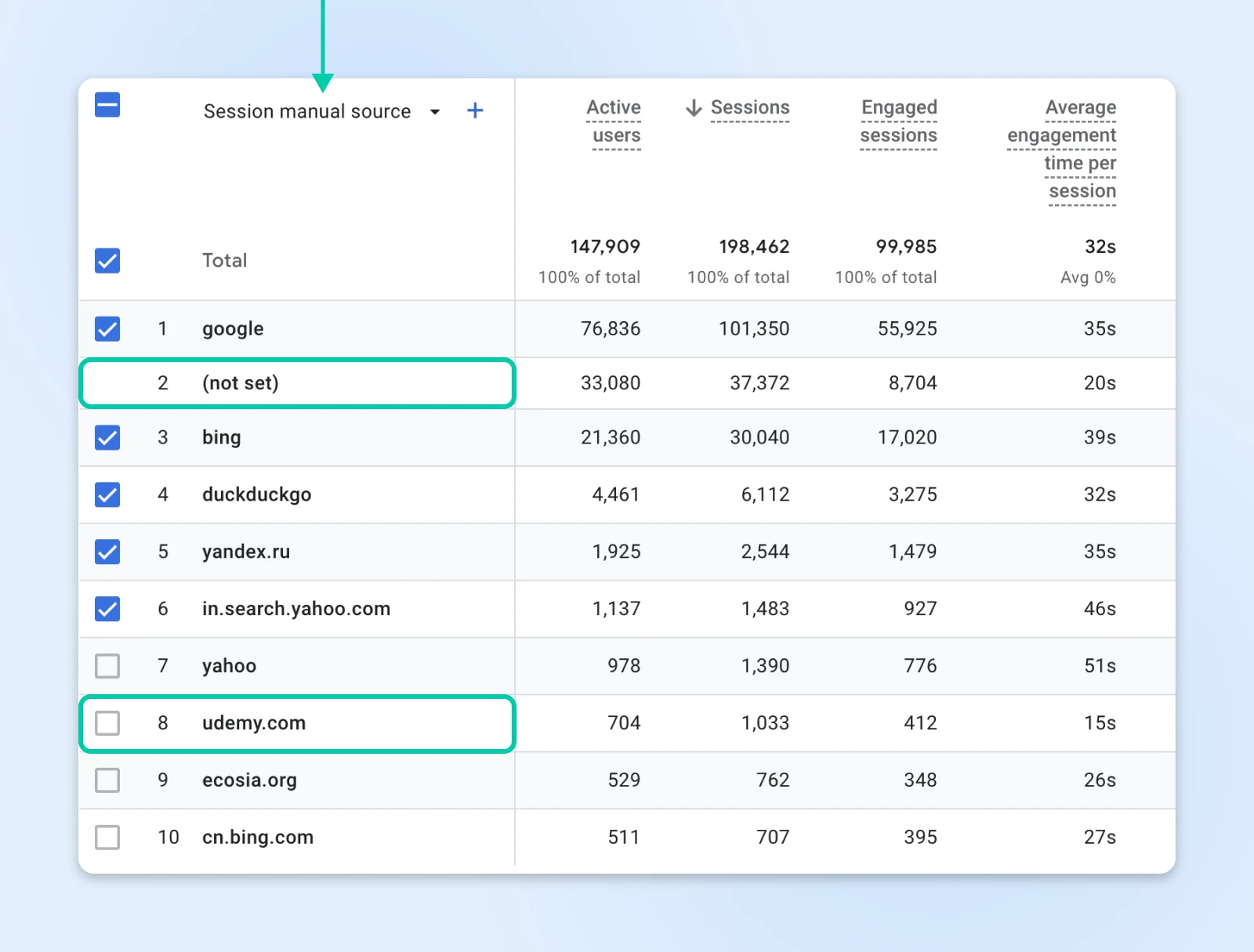

The hyperlink clicks that don’t have UTM parameters get clubbed into the (not set) supply. For the remainder, you’ll see the suitable supply names. If you wish to dig deeper, you should use the Google Search Console to search out out the key phrases driving visitors.
Be aware that not all of them are manually tagged. Engines like google (on this case), and a few websites auto-append their UTM parameters to advertise themselves and to assist customers see the visitors supply from their web site simply.
What Data Can UTM Hyperlinks Carry?
Every click on on a UTM hyperlink carries details about the place a click on got here from, which marketing campaign triggered it, and even which particular component caught your customer’s consideration. All of it depends upon the way you construct out the hyperlink (sure, it’s guide work).
Say you’ve got this hyperlink to advertise on social media:
“https://www.dreamhost.com/internet hosting”
Clicking on this hyperlink proper now will solely present imprecise info like “social” or “natural” in analytics. Right here’s how one can add knowledge to the hyperlink:
1. Marketing campaign supply (“utm_source”) – Required
The “utm_source” data the place your guests originated.
If you mark a hyperlink with “utm_source=e-newsletter,” you’re basically saying, “This customer got here from our electronic mail listing.”
Mark it as “utm_source=instagram” as an alternative of e-newsletter, and Google will present the supply as Instagram (even when the clicking really got here out of your e-newsletter).
2. Marketing campaign medium (“utm_medium”) – Required
With “utm_source,” you recognize the place a consumer got here from.
However did they arrive through a paid commercial (“utm_medium=cpc”)? By means of an natural social media publish (“utm_medium=social”)? Or maybe by your electronic mail advertising efforts (“utm_medium=electronic mail”)?
Setting “utm_medium” will assist you to decide the automobile by which the visitors was delivered.
3. Marketing campaign identify (“utm_campaign”) – Required
You already know {that a} click on is coming from a advertising electronic mail, however you don’t know which one.
Your marketing campaign identify serves as a approach so that you can determine precisely which marketing campaign despatched this click on.
This additionally helps you with conversion price optimization (CRO) as you possibly can tag every CTA uniquely, providing you with knowledge on which CTA through which e-newsletter (or every other advertising materials) was clicked.
Conversion Price Optimization (CRO)
Conversion Price Optimization (CRO) refers to any apply geared towards bettering the variety of conversions that you just get from web sites, electronic mail campaigns, and advertisements.
As an example, “utm_campaign=spring_sale_2025” teams all visitors associated to your spring promotion, no matter supply or medium.
4. Marketing campaign ID (“utm_id”) – Non-obligatory
The marketing campaign ID parameter permits you to connect a singular identifier to your marketing campaign.
It’s helpful when your advertising efforts want that further layer of element. Utilizing
“utm_id,” you possibly can distinguish between related campaigns or sub-campaigns that share the identical supply, medium, or marketing campaign identify.
For instance, for those who run a spring sale throughout a number of platforms, assigning every variation a singular ID helps monitor which performs finest.
5. Marketing campaign time period (“utm_term”) – Non-obligatory
For paid search campaigns, “utm_term” captures the precise key phrases that triggered your advert.
This provides you visibility into which search phrases drive invaluable visitors, serving to you refine your bidding technique. If you happen to’re focusing on a number of key phrases in a marketing campaign, tagging every with “utm_term” permits you to examine efficiency.
For instance, for those who’re working advertisements for internet hosting and need to monitor the key phrase “finest internet hosting,” you possibly can add “utm_term=best_hosting” to the hyperlink.
With this, you possibly can see which key phrases appeal to clicks, and optimize your paid search efforts accordingly.
6. Marketing campaign content material (“utm_content”) – Non-obligatory
The “utm_content” parameter is helpful for A/B testing.
In case you have a number of variations of an advert, electronic mail, or CTA resulting in the identical vacation spot, this tag helps determine which model performs finest. Use it to distinguish between a banner advert and a textual content advert or monitor which button in an electronic mail acquired extra clicks.
As an example, for those who’re testing two completely different electronic mail CTAs — one that claims “Get Began” and one other that claims “Declare Your Low cost” — you possibly can tag them individually on the identical web page too.
How To Set Up UTM Parameters: A Step-by-Step Information
It’s straightforward to construct a UTM hyperlink. You could possibly do it manually by typing the hyperlink or utilizing the Google Marketing campaign URL Builder to do the identical.
1. Begin With Your Base URL
Establish the URL of the web page you need to promote. For instance:
“https://www.dreamhost.com/internet hosting”
2. Add UTM Parameters
UTM parameters are added to the URL after a query mark (“?”).
- Every parameter consists of a key-value pair, joined by an equal signal (“=”).
- A number of parameters are separated by ampersands (“&”).
- Use underscores (“_”) to separate phrases inside parameter values for higher readability. As an example, “utm_source=e-newsletter” signifies that the visitors got here from a e-newsletter.
Right here’s how one can construct your URL with UTM parameters:
- Marketing campaign supply (“utm_source”): Identifies the platform or supply, akin to “utm_source=fb”.
- Marketing campaign medium (“utm_medium”): Specifies the advertising medium, like “utm_medium=electronic mail.”
- Marketing campaign identify (“utm_campaign”): Names the precise marketing campaign, for instance, “utm_campaign=spring_sale_2025.”
- Marketing campaign time period (“utm_term”): Used for paid search to determine key phrases, e.g., “utm_term=affordable_hosting.”
- Marketing campaign content material (“utm_content”): Differentiates related content material or hyperlinks, helpful for A/B testing, akin to “utm_content=cta_button.”
Combining these, your URL may seem like this:
“https://www.dreamhost.com/internet hosting?utm_source=fb&utm_medium=social&utm_campaign=spring_sale_2025&utm_content=cta_button”
3. Use a UTM Builder Device
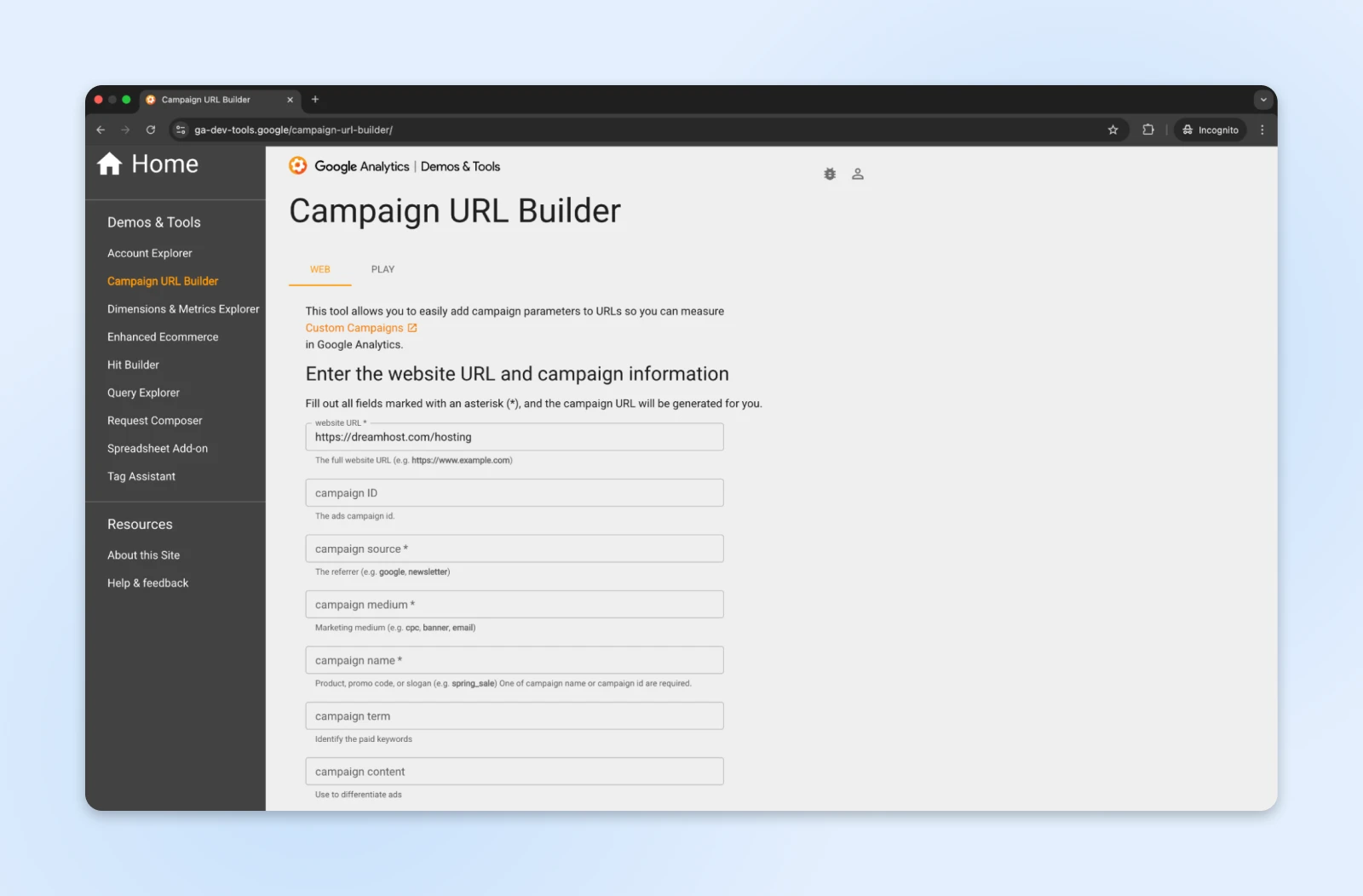

For a less complicated, extra correct course of, attempt a free UTM builder instrument akin to Google’s Marketing campaign URL Builder. It permits you to enter every parameter as a separate enter within the kind. And when you’re completed, the Marketing campaign URL Builder combines it right into a hyperlink you possibly can copy.
This makes the method straightforward and error-free.
4. Take a look at Your Hyperlinks
Earlier than deploying your UTM-tagged URLs, check them to ensure they direct customers to the proper web page and that your analytics platform data the parameters precisely.
How? Simply click on on the hyperlink and see if the clicking reveals up in your Analytics dashboard from the parameters as you’ve set them.
How To Analyze and Make Sense of UTM Information
When you’ve carried out UTM parameters in your advertising hyperlinks, the subsequent step is to investigate the collected knowledge to realize actionable insights. Right here’s learn how to successfully interpret UTM knowledge:
Step 1: Entry Your Analytics Platform
Start by logging into your net analytics instrument, akin to Google Analytics. Navigate to the part the place marketing campaign knowledge is displayed.
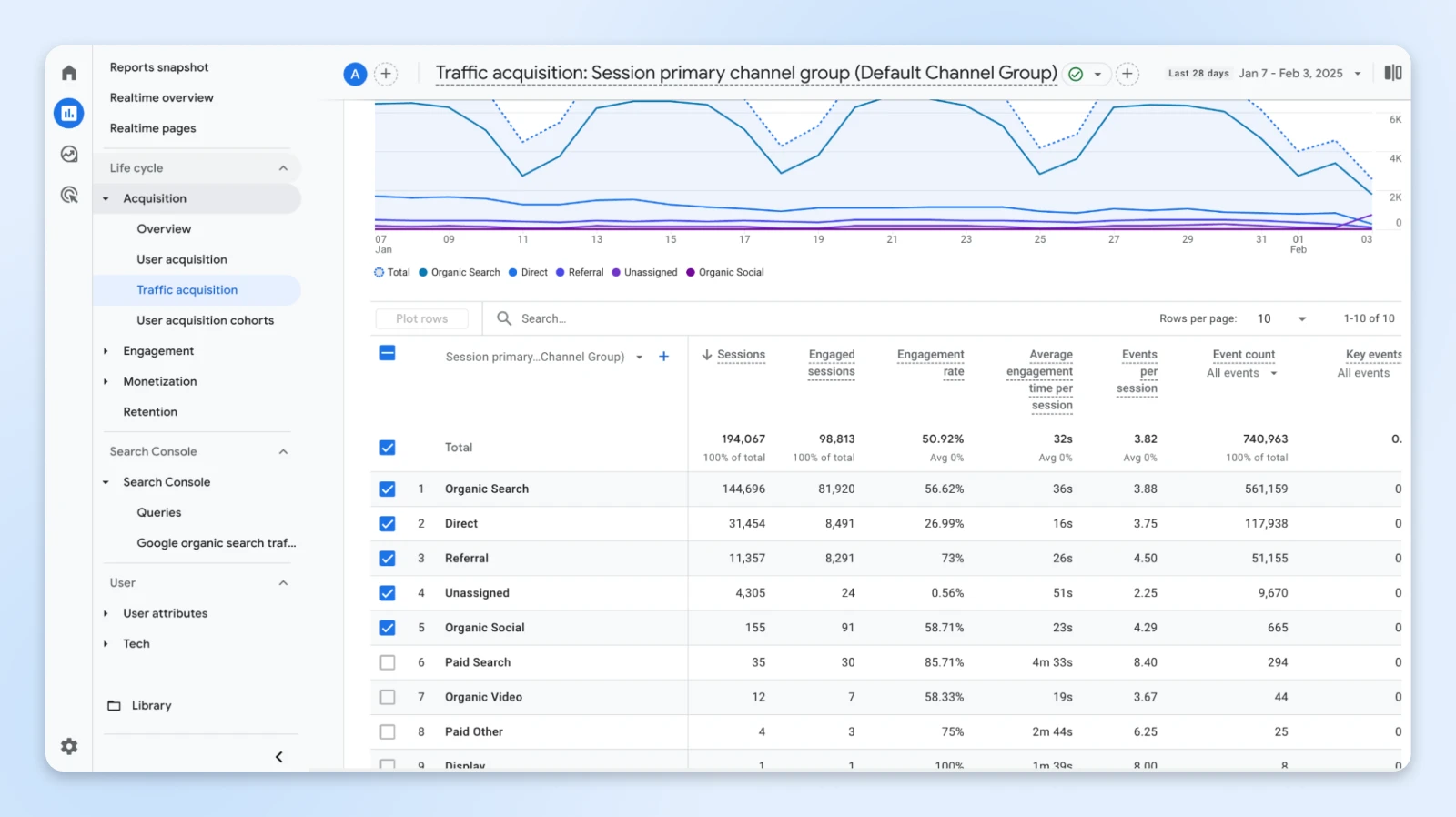

In Google Analytics 4 (GA4), you will discover this underneath Acquisition > Visitors Acquisition.
Step 2: Customise Your Experiences
To give attention to UTM parameters, customise your stories.
Main dimension: Set this to “Session supply” to view the origin of your visitors.
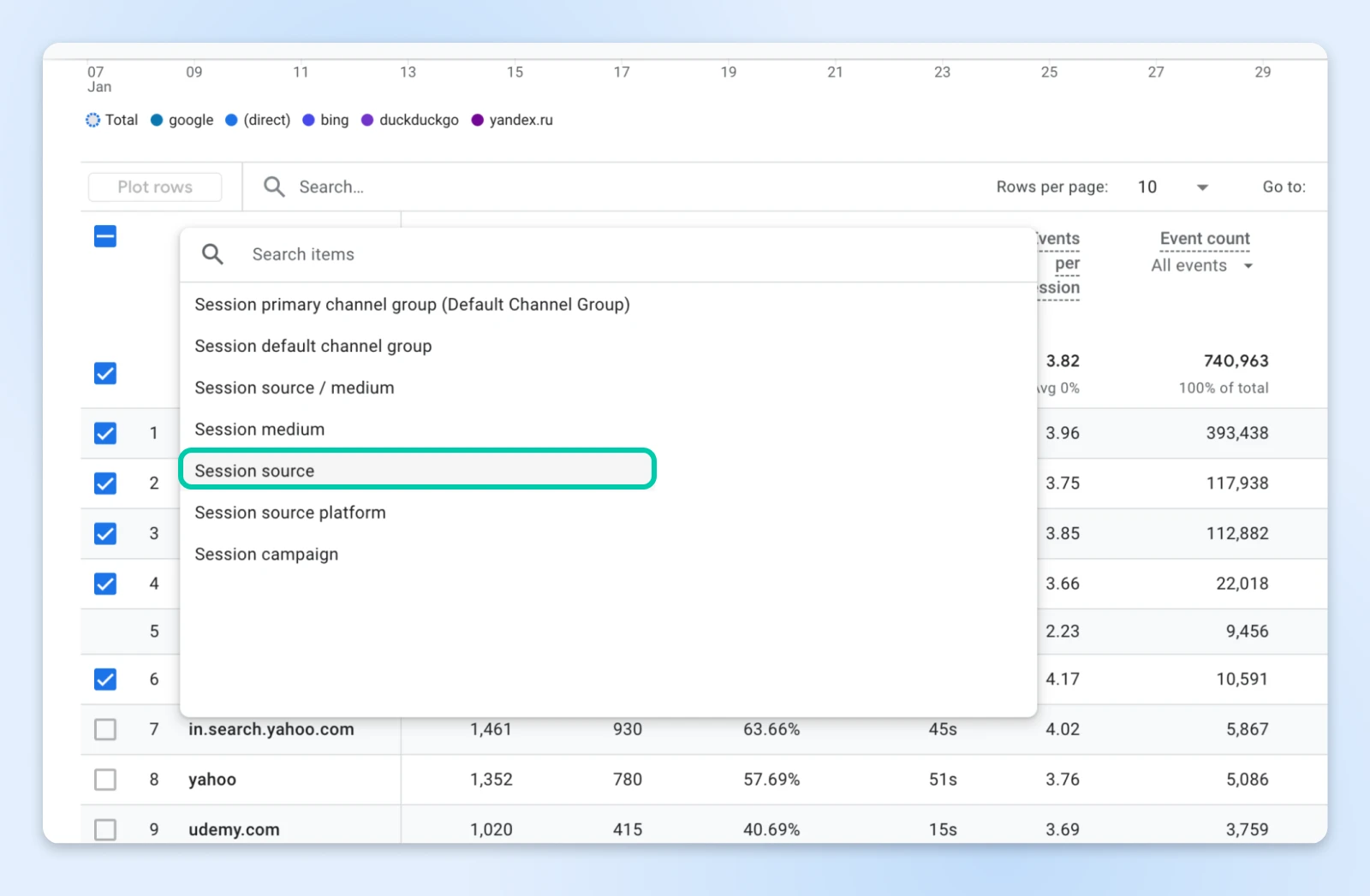

Secondary dimension: Add Marketing campaign to see which campaigns are driving visitors.
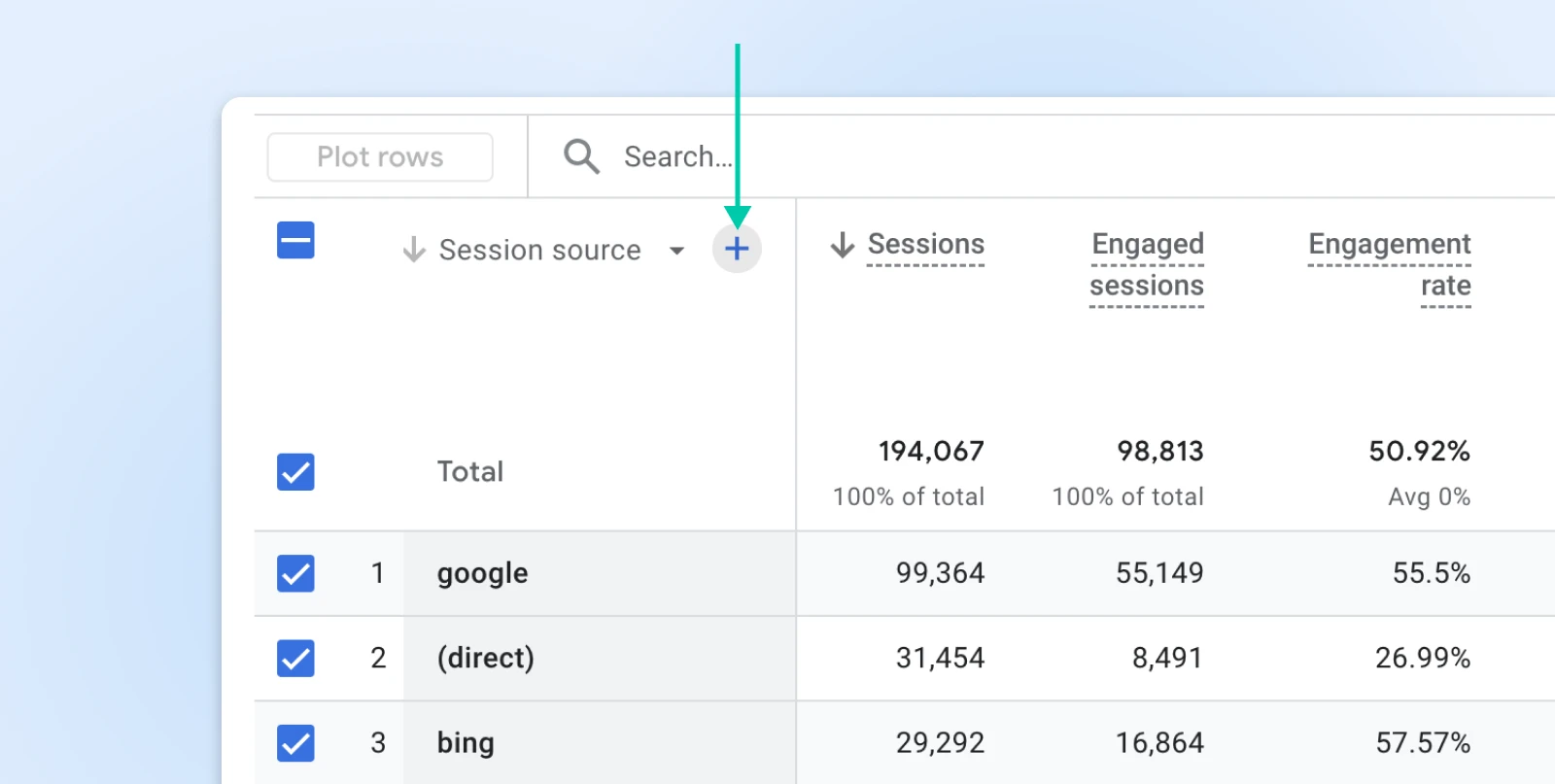

Extra filters: Embody filters for “Time period” and “Content material” for those who’ve used these parameters, permitting for a extra granular evaluation.


Step 3: Consider Key Metrics
Analyze the next web site metrics to evaluate marketing campaign efficiency:
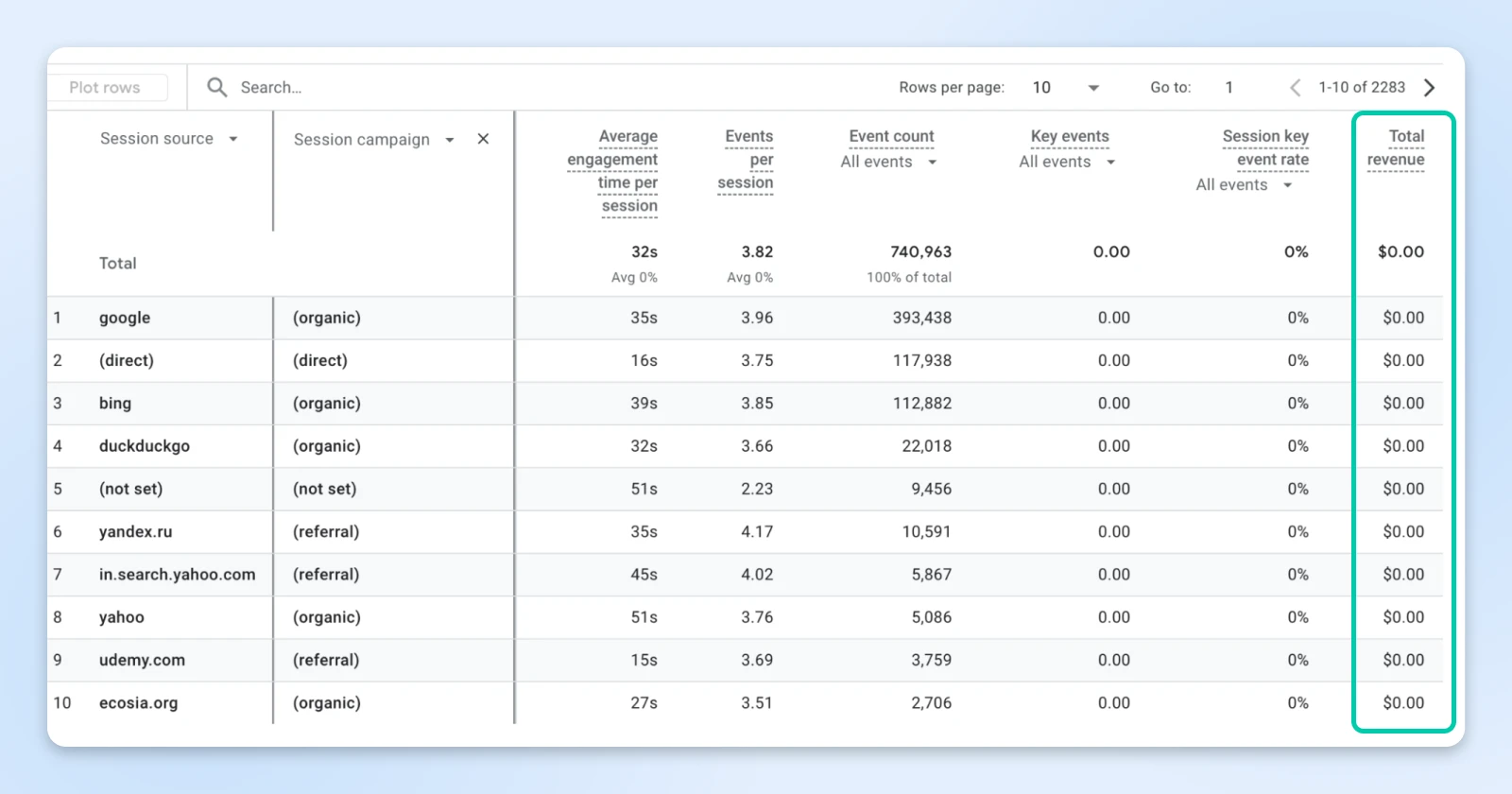

- Classes: The variety of visits initiated from every supply/medium.
- Bounce price: The share of single-page classes; a excessive price might point out irrelevant visitors.
- Conversion price: The share of classes that accomplished a desired objective, akin to making a purchase order or signing up for a e-newsletter.
- Common session length: The typical time customers spend in your website; longer durations usually recommend greater engagement.
Step 4: Evaluate Efficiency Throughout Campaigns
With this knowledge in hand, you possibly can determine which campaigns, sources, or mediums are best.
As an example, you may uncover that electronic mail campaigns (“utm_medium=electronic mail”) have a better conversion price in comparison with social media campaigns (“utm_medium=social”), informing your future advertising methods.
If you mix this info with the variety of classes, conversions, and income values (for those who’ve built-in funds knowledge with Google Analytics), it turns into clear what sources are producing worth for the enterprise and which of them must be improved.
Step 5: Discover Areas for Enchancment
This brings us to the ultimate step.
If sure campaigns present excessive bounce charges or low conversion charges, begin digging into them to grasp what’s happening.
Some essential elements, akin to touchdown web page relevance, viewers focusing on, and the readability of your call-to-action, can all have an effect on conversions.
Professional Suggestions for Efficient UTM Parameter Administration
UTMs are straightforward to create — they usually’re simply as straightforward to get flawed.
Give it some thought: if somebody by chance sorts “utm_source” as “utmsource,” you’ve misplaced the power to trace that hyperlink since Google can not acknowledge that UTM parameter.
Develop a Constant Naming Conference
Suppose you’re making an attempt to collect knowledge on how CTA buttons are performing throughout your web site. For the info to get pulled collectively appropriately, you want each UTM hyperlink added to a CTA to observe a standardized naming conference.
If somebody names the “utm_source=ctabutton” and one other particular person makes use of “utm_source=cta_button,” you’ll have a tough time merging the info and making sense of it.
To stop that, set up a standardized strategy for naming your UTM parameters to make sure consistency and accuracy in your knowledge.
For instance, resolve whether or not to make use of “electronic mail” or “e-newsletter” for the “utm_medium” parameter and apply it uniformly throughout all campaigns. Consistency prevents knowledge fragmentation and helps with a extra simple evaluation.
Use a UTM Parameter Builder
We’ve talked about utilizing Google’s Marketing campaign URL Builder. Different related instruments like utmbuilder.web and utmbuilder.com assist you to create URLs with UTM parameters effectively.
Whereas it’s not essential to make use of these instruments, it helps you keep consistency and ensure there aren’t any errors within the created UTM hyperlinks.
Keep a Centralized Monitoring Doc
Hold a shared spreadsheet or database the place all UTM-tagged URLs are recorded. Embody particulars such because the marketing campaign identify, parameters used, creation date, and the staff member accountable.
Right here’s an instance of the kind of sheet you possibly can create.
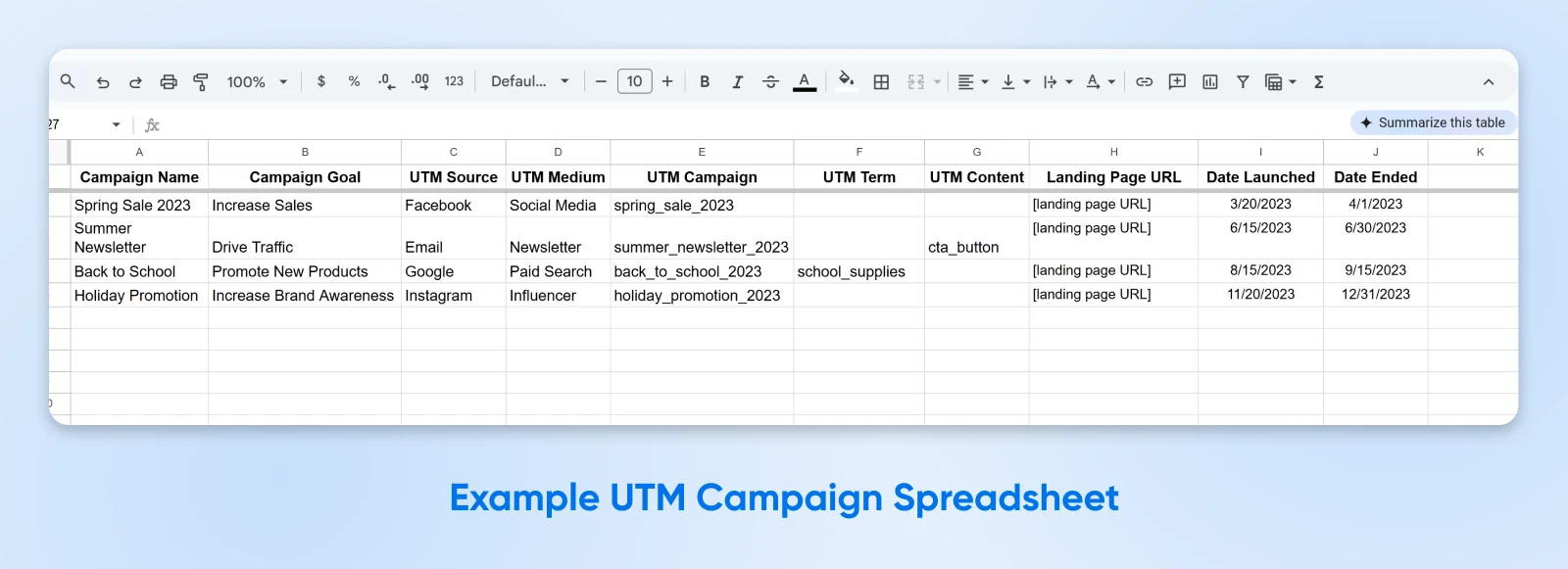

Go additional and create dropdowns for every of the UTM parameters so your staff can solely choose from the standardized parameters as an alternative of utilizing custom-made ones for every marketing campaign.
Take a look at Your UTM-Tagged Hyperlinks Earlier than Deployment
Earlier than launching your campaigns, totally check all UTM-tagged hyperlinks to make sure they direct customers to the proper touchdown pages and that the parameters are precisely captured in your analytics platform. You don’t need misconfigured UTM URLs floating round when you watch for knowledge to point out up.
Keep away from Utilizing UTM Parameters for Inner Hyperlinks
UTM parameters are designed for monitoring exterior visitors sources.
Making use of them to inside hyperlinks can disrupt session monitoring, show inaccurate knowledge, and overwrite knowledge if a customer clicks on completely different hyperlinks whereas shopping your content material.
Use different strategies, akin to occasion monitoring, to watch inside hyperlink efficiency.
Shorten Prolonged URLs for a Higher Person Expertise
Lengthy URLs with a number of UTM parameters can seem cluttered and will deter customers from clicking.
URL shortening companies like Brief URL, Bitly, and plenty of others assist you to create cleaner, extra user-friendly hyperlinks with out shedding monitoring capabilities.
Keep in mind the DreamHost UTM hyperlink we created?
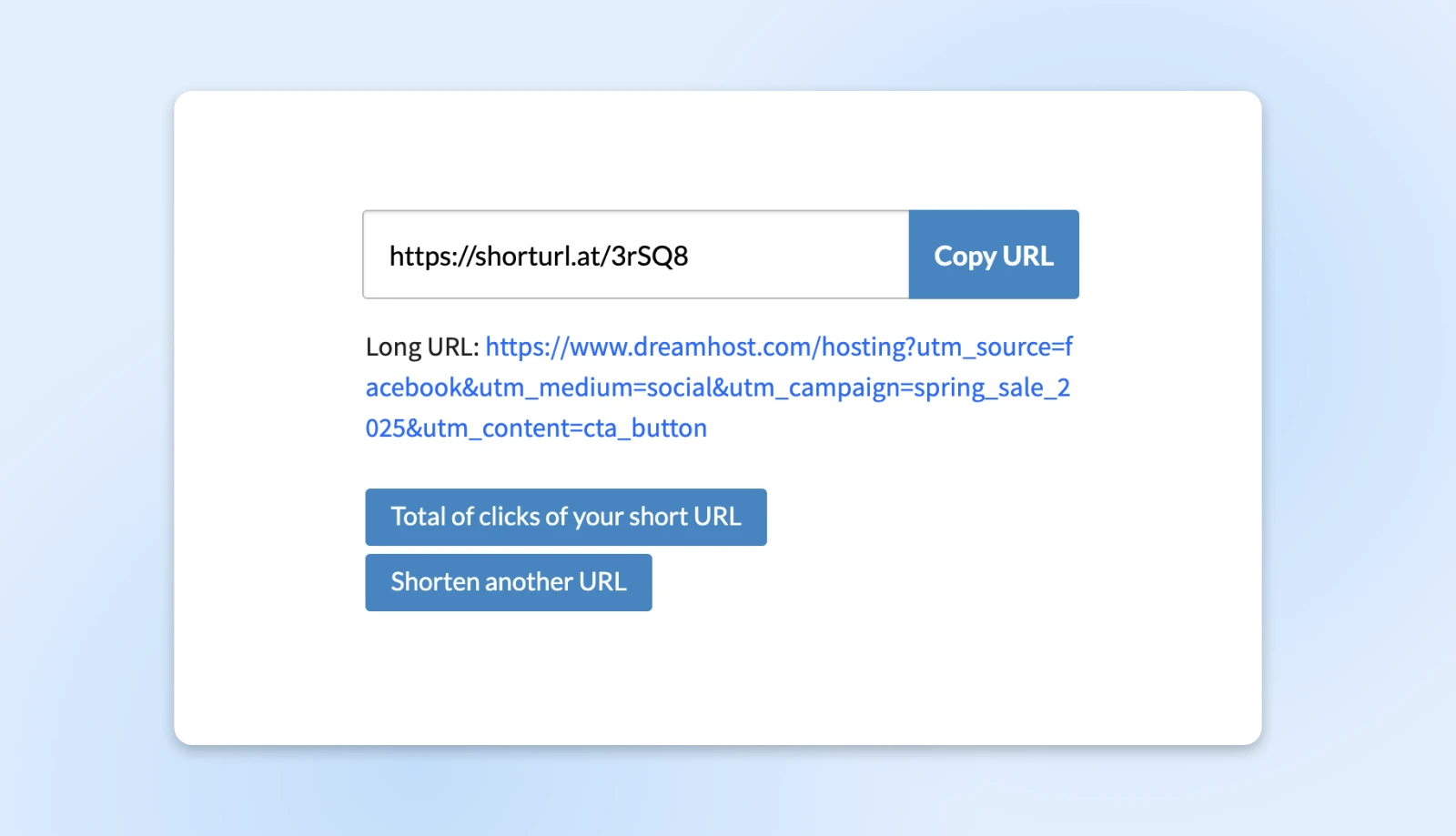

That is what it seems like when shortened.
Begin Small, Win Huge with UTM Hyperlinks
Implementing UTMs is a long-term sport. Don’t fear; you don’t want to begin tagging each single hyperlink tomorrow.
Nevertheless it’s some of the accessible methods to improve your advertising from guesswork and instinct to a data-backed technique.
So, listed here are your speedy subsequent steps:
- Choose your busiest visitors channel.
- Create UTM hyperlinks in your subsequent week of content material.
- Watch your analytics let you know precisely what’s driving outcomes.
- Rinse and repeat along with your subsequent channel.
Each profitable advertising technique is constructed on strong knowledge — and UTMs provide you with that knowledge.
Did you take pleasure in this text?

